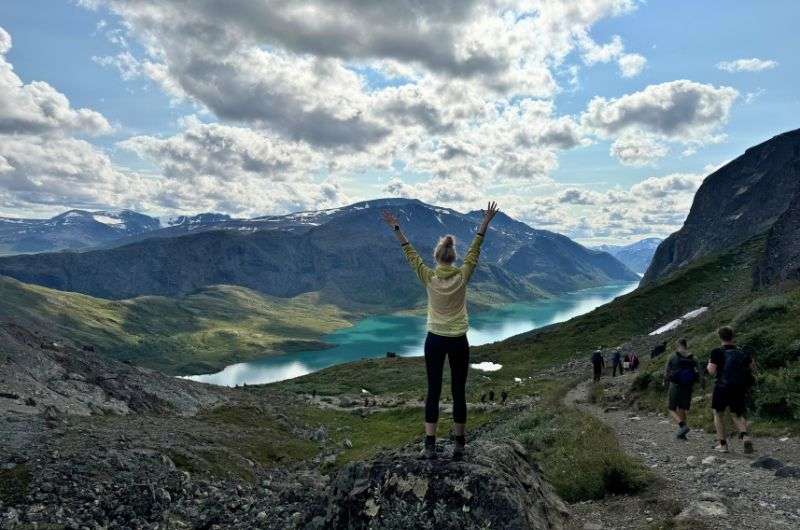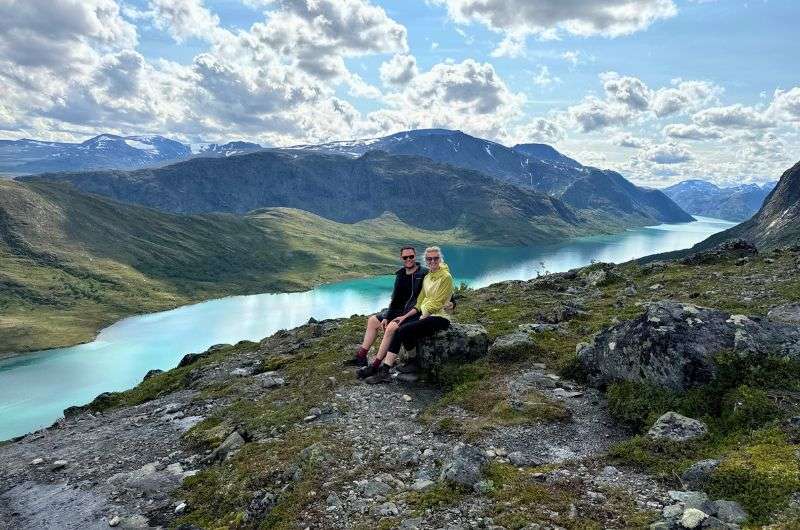The Ultimate Guide to the Besseggen Ridge Hike: 8 Tips/FAQs


The Besseggen Ridge hike is one of Norway’s most famous treks—possibly the most famous in Jotunheimen National Park. Even though it is literally a walk in the park, take it from me: don’t go in too confident. It’s a 14-kilometer (9-mile) adventure across rugged terrain, complete with pretty steep climbs, a narrow ridge, and an elevation gain of around 1,100 m (3,600 ft). Yeah, gulp.
While it’s definitely not a breeze (though it is very windy), this epic route is doable for anyone with decent levels of fitness and stamina. I’d recommend it for the truly INSANE lake views alone, but honestly, the atmosphere on the hike feels totally different from the rest of Norway. There was this rugged, wild, almost American West vibe that I didn’t see coming. Hands down, one of the best hikes in the country.
In this ultimate guide, I’ll share my personal tips and FAQs from the Besseggen hike, sprinkled with some hard-earned wisdom (if I do say so myself). Let’s get into it!

I took this Besseggen Ridge hike with my girlfriend and now I've written down everything you need to know about it
Sometimes, all you need to do is take the first step... I've filtered out the best hotels around Besseggen Ridge for you
Save it for yourself to come back to later, or share with your friends on social media!
Besseggen Ridge Hike: elevation gain and other statistics
- Distance: 14.3 km (8.9 mi), point-to-point
- Elevation gain: 1,074 m (3,523 ft)
- Difficulty: Hard
- Hiking time: 6–8 hours
- Trailhead: Google Maps link to trailhead
Besseggen Ridge Hike: trail map

See the route in more detail on Alltrails
Tip 1: The best time to do the Besseggen Ridge hike is summer
The best time to hike Besseggen is from mid-June to mid-October, when the boats on lake Gjende run regularly (see tip 5, “Which ferry terminal to start at”, below).
As to be expected of any Norwegian hike, summer is the most popular time of year for Besseggen hiking. For fewer crowds, avoid peak season in July and early August, as the boats fill up fast, the trail gets busy, and you’ll probably get stuck behind some slowpokes at least a couple of times.
For a more peaceful experience, plan your hike for outside high season. Bonus tip: Even doing the hike on a weekday might help you avoid the masses.
While winter hikes are possible, they require a professional guide due to the icy, dangerous conditions. Fun fact: Snow can linger on the Besseggen Ridge until mid-June!

Summer is the best for the Besseggen Ridge hike
Another mini tip: When it comes to the best time of day to do the hike, the rule of thumb is the earlier the better. Again, essentially, this is so you can avoid the worst of the crowds.
Tip 2: Half a day is how long the Besseggen hike takes
The Besseggen Ridge hike takes around 6–8 hours, depending on how fit and experienced you are, how many breaks you take, and of course, how many times the views stop and mesmerize you.
Reminder: It’s a 14-kilometer (9-mile) trek on hilly terrain, and you’ll gain some 1,100 meters (3,500 ft) in elevation.
The ridge itself is steep, narrow, and windy, but as long as the weather conditions are okay, you won’t need any serious climbing gear. The toughest part is around Veslfjellet, the highest point, but once you’re over that, it’s smooth sailing.

Reserve at least 8 hours for the Besseggen hike. It will be a rewarding shift!
If it gets too intense, you can always turn back. That’s the beauty of Besseggen Ridge: since the best bit is more-or-less in the middle, you don’t have to hike the entire trail.
Tip 3: Where to stay to do the Besseggen Ridge hike (my hotel recommendation)
Although there aren’t any major towns near the Besseggen Ridge, there are a few hotels, guesthouses and campsites dotted along the 51 road near the Gjendesheim ferry terminal.
If you’ve read any of my blog before, you know I don’t do camping or basic lodges, so I’d recommend the Radisson Blu Resort. It’s in the village of Beitostølen, which is 34.4 km (21.3 mi) south of the ferry terminal at Gjendesheim. We got a clean room, a comfortable bed, and a good breakfast. Plus, they have a pool, so it was both refreshing and relaxing to take a dip there after a long day of hiking.

Besseggen Ridge hike
Tip 4: How to prepare for the Besseggen hike—weather, clothing, checklist
If you follow these three pointers, you’ll be all set to hike the Besseggen Ridge safely and comfortably...
Check the weather forecast
Even if you’ve been led to believe you’re getting sunshine and rainbows, Norwegian weather has a sense of humor, so don’t trust it blindly! Always check the weather forecast at yr.no before you head out. And maybe chat with a local—they’ve seen things.
Be ready to get even just a little wet, because good weather can turn into rain quite abruptly. And if the forecast calls for gale-force winds, a torrential downpour, or a lightning show, maybe save the hike for another day. No view is worth getting blown off a ridge!
Tip: Stay in the area at least two days to increase your chances of getting good hiking weather.

The weather in Norway is unpredictable. You may even encounter snow. In the summer!
What to wear
Proper hiking shoes aren’t just a suggestion—they’re your best friend. And by “proper,” I mean broken-in boots, not a shiny new pair that’ll give you blisters halfway up. (I know I sound like your dad at this point, but stick with me.)
A windproof and waterproof jacket is a must. Unless you want to feel the full effect of being blown around like a windsock.
Beneath your outer layers, you want a warm, cozy sweater and thermal leggings.
Oh, and don’t forget the extras: a hat, a scarf, and some gloves. You’ll thank me if it starts to feel like the Arctic halfway up. And if it’s a milder day, hey, you’re better safe than sorry.
What to bring: a checklist
- A hiking backpack with sturdy, comfortable straps, and at least a 30-liter capacity
- A map (a paper or offline one; don’t think you can necessarily rely on your phone up there)
- A compass (again, in case your phone won’t work)
- A headlamp (in case you’re not hiking in the summer)
- First-aid equipment
- Enough food and water to last you the entire hike
- Plastic bags for your trash

Be well equipped for the changing conditions on Besseggen Ridge
Tip 5: Which ferry terminal to start at (Memurubu or Gjendesheim)
What do the Besseggen Ridge hike and a role-playing game have in common? They both give you the power to choose your own adventure! Yes, when you go to hike the Besseggen Ridge, you get a choice of not one trailhead, but two, PLUS a secret one!
The two main starting points are at either side of the ridge, and there’s a ferry running between them on lake Gjende. The journey between these trailhead terminals takes around 20 minutes’ you can find ferry times and buy ferry tickets on this website - gjende.no/en/
But be aware: Between early October and early June, ferries don’t run every day; times are more erratic.
Side note: The third trailhead, which doesn’t involve a ferry, is the base of an alternative loop hike around Bessvatnet lake.

Map of the Besseggen Ridge area, pinpointing all trailheads
Trailhead A: Memurubu
Most people start the Besseggen Ridge hike from Memurubu, by the center of Gjende lake. It’s said to be easier to go this way because you hike up (not down) the steepest part of the route: the ridge itself. To get to Memurubu and hit the trail, you need to catch the ferry from Gjendesheim.
Here’s the Google Maps link to the Memurubu trailhead.
Trailhead B: Gjendesheim
Alternatively, if you want more of a challenge and believe in the strength of your knees, you can hike the other way across the Besseggen Ridge from Gjendesheim. This means that getting the ferry (from Memurubu) will be the last thing you do, after the hike.
My advice: Seriously, go from this side. I did, and although coming down the ridge was tough, I was happy to have the steepest uphill climb over with right at the beginning. (Memurubu, meanwhile, generally starts off easier and gets more difficult.) Plus, there’s something magical about hopping on a boat to cruise past the same mountain you’ve just conquered.

Gjendesheim trail
Here’s the Google Maps link to the Gjendesheim trailhead.
Secret trailhead C: Bessheim
A slightly different route that’ll see you over the Besseggen Ridge is the one around Bessvatnet lake, the smaller of the two lakes that the ridge straddles. This trail doesn’t require you to take a ferry and starts from nearby Bessheim (Google Maps link).

See the route in more detail on Alltrails
Why do this hike instead of the Besseggen hike? Put simply, it’s less popular, which means fewer crowds. But on the other hand, it’s slightly longer and the terrain is just as challenging (if not more so). Which one you choose is totally your call.
Parking at Gjendesheim
The parking lot for the Gjendesheim ferry terminal and trailhead is actually 2 km (1.2 mi) away, just off the 51 road. If you want to treat yourself before you crank your body into high gear, you can even get a shuttle bus up once you’re parked.
It costs NOK 130 (USD 11.94) to park your car for the day and NOK 85 (USD 7.81) for a return shuttle bus ticket, which I thought was all very reasonable. Book in advance via this website.

Parking at the Gjendesheim trail
Hey, save this for later! It’s about one of my other amazing hiking experiences in Norway:

FAQ 1: Is the Besseggen hike worth it?
If you love epic scenery and adventure, it's totally worth the physical exertion. The Besseggen Ridge hike offers jaw-dropping views of two turquoise lakes, rugged mountains, and best of all, a ridge that’ll get your heart racing. It’s challenging but rewarding—the sense of accomplishment you get when you’re straddling the two lakes is unbeatable.
Sometimes, all you need to do is take the first step... I've filtered out the best hotels around Besseggen Ridge for you
Save it for yourself to come back to later, or share with your friends on social media!
FAQ 2: Will I need a Besseggen hiking guide?
Since it’s a busy trail and therefore not particularly difficult to get lost, hiking the Besseggen Ridge is perfectly doable without a guide. However, if you’re still unsure, guided hikes are available.
Generally, though, since the hike is demanding, if you’re not physically fit, I wouldn’t recommend doing this hike with or without a guide.

If you use this guide as a back-up, you'll be good!
FAQ 3: What’s the best thing to do in Jotunheimen National Park?
The best thing to do in Jotunheimen National Park is, of course, hike its legendary trails. What’s more, Jotunheimen is an ideal destination for skiers and cyclists who crave the wonderful combination of fresh air and undisturbed nature. Other popular activities in Jotunheimen include glacier walking, rafting, climbing, caving, canyoning, and horseback riding.
Hop over to my other article for some more epic hikes in Jotunheimen:
This post contains affiliate links. I earn a small commission if you make bookings through my links, at no additional cost to you. Thank you for your support!










Comments | Thoughts? Give us a shout!